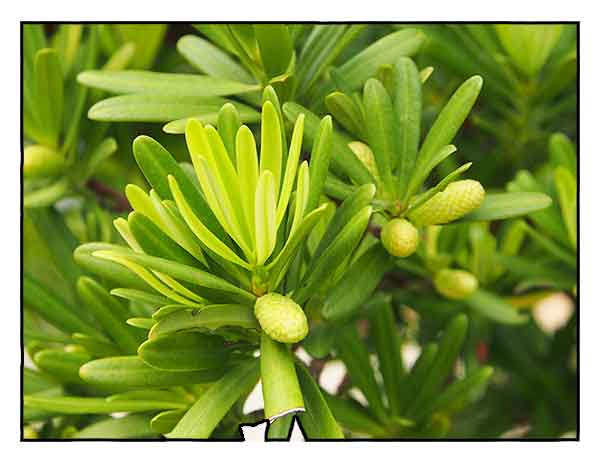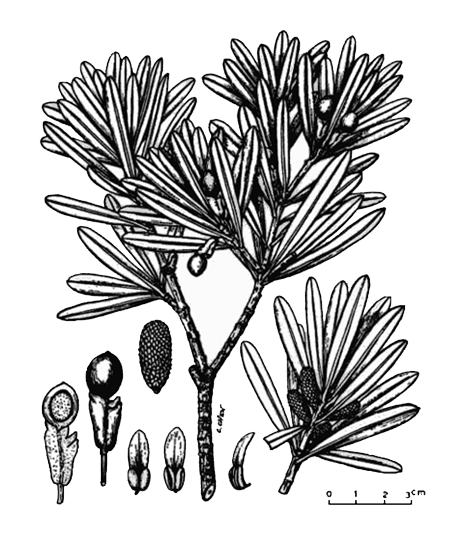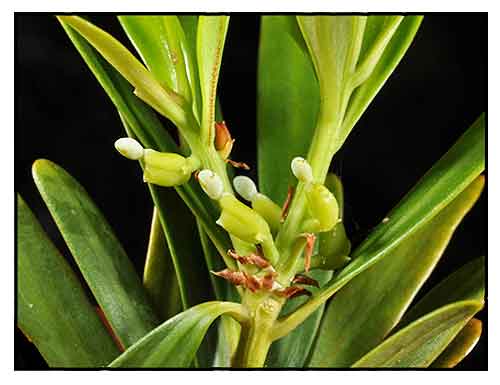 Gen info Gen info
- Podocarpus costalis is a species of conifer in the family Podocarpaceae.
-
Endangered because of limited growth to specific habitat, limited to as few a five localities in the Philippines and Taiwan, and worsened by continuous removal of mature plants for horticulture or as potted plants or bonzai culture. Collection from the wild is illegal in Taiwan and the Philippines. (2)
- The plant is often confused with P. polystachyus because of the similar habitats and leaves. (2)
- The Ivatans in Batanes refer to it as "Batanes pines."
Botany
Podocarpus costalis is a shrubby tree to 5 m tall. Bark smooth, greenish, peeling in thin flakes. Crown broad, with numerous horizontal, contorted branches bearing branchlets densely clothed with foliage. Twigs short, stout, light green, inconspicuously grooved between the attached leaf bases. Resting buds nearly spherical, 2-4 mm long, tightly wrapped by triangular bud scales with spreading tips. Leaves densely and evenly standing out from or forward around and along the twigs or more concentrated near the tips, leathery, lasting 2-4 years, dull bluish green above, yellowish green  beneath, (2.5-)4-7 cm long (to 9 cm in juveniles), (5-)7-10 mm wide (to 13 mm in juveniles). Blades straight, the margins flat or slightly turned down, widest beyond the middle, tapering abruptly to a roundly triangular, round, or even slightly notched tip and gradually to a wedge-shaped base on a short petiole 2-3 mm long. Midrib fairly prominently raised above, more broadly and shallowly raised beneath, with three resin canals beneath the midvein, wings of support tissue extending out to the sides, and a partial hypodermis beneath the upper epidermis. Pollen cones 2.5-3.5 cm long and 6-8(-10) mm wide, one directly in the axils of the foliage leaves. Pollen scales with a narrow, tonguelike, upturned tip about 3 mm long. Seed cones on a short, leafless stalk (2-)4-6(-10) mm long, with a pair of 1.5 mm long needlelike bracteoles that are quickly shed, the reproductive part with two unequal bracts, these and the axis becoming swollen and juicy, bright red to purple, (7-)10-15 mm long by 8-9 mm thick. Fertile seed scale one, the combined seed coat and epimatium leathery over a hard inner shell, dark blue, (7-)9-10 mm long by 6-8 mm thick, with an inconspicuous beak. (3) beneath, (2.5-)4-7 cm long (to 9 cm in juveniles), (5-)7-10 mm wide (to 13 mm in juveniles). Blades straight, the margins flat or slightly turned down, widest beyond the middle, tapering abruptly to a roundly triangular, round, or even slightly notched tip and gradually to a wedge-shaped base on a short petiole 2-3 mm long. Midrib fairly prominently raised above, more broadly and shallowly raised beneath, with three resin canals beneath the midvein, wings of support tissue extending out to the sides, and a partial hypodermis beneath the upper epidermis. Pollen cones 2.5-3.5 cm long and 6-8(-10) mm wide, one directly in the axils of the foliage leaves. Pollen scales with a narrow, tonguelike, upturned tip about 3 mm long. Seed cones on a short, leafless stalk (2-)4-6(-10) mm long, with a pair of 1.5 mm long needlelike bracteoles that are quickly shed, the reproductive part with two unequal bracts, these and the axis becoming swollen and juicy, bright red to purple, (7-)10-15 mm long by 8-9 mm thick. Fertile seed scale one, the combined seed coat and epimatium leathery over a hard inner shell, dark blue, (7-)9-10 mm long by 6-8 mm thick, with an inconspicuous beak. (3)
 Distribution Distribution
- Native to the Philippines.
- Also native to Nansei-shoto, Taiwan. (1)
- Grows primarily in the wet tropical biome.
- Grows in island scrub, low forest, or limestone bluff or sea stack habitat, at elevations from sea level to 300 m.
- Restricted to the Babuyan, Batan, and Lanyu Islands between Luzon and Taiwan, the Polilio Islands off the eastern coast of Luzon, and the Bucas Islands off northern Mindano.
(3)
- IUCN listed as "Endangered".
Constituents
- Ethanolic leaf extract yielded phenol, tannins, flavonoids, carbohydrates, and reducing sugars. (see study below) (4)
- Podocarpus costalis leaves are rich in phenolics with average content of 56.19 µg/g while leaves = flavonoids averaged 7.57µg/g. (see study below)
(5)
- P. costalis ethanolic extract of leaves yielded alkaloids, flavonoids, glycosides, tannins and triterpenes, with absence of saponins and phytosterol. (see study below) (8)
Parts used
Leaves, aerial parts.
Uses
Edibility
- Fruits are edible, described by Batanes locals as "delicious, sweet, somewhat sticky".
- Potential for jams, preserves, teas, tarts.
Folkloric
- No reported folkloric medicinal use in the Philippines.
Others
- Wine: In Batanes, fruits used for wine making.
Studies
• Antimicrobial / Leaves: Study evaluated the antimicrobial properties of Podocarpus costalis leaf extract. A 100% leaf extract showed highest activity against Escherichia coli with mean zone of inhibition of 11.38 mm. (see constituents above) (4)
• Antioxidant / Cytotoxicity / Phenolic and Flavonoid Content / Leaves: Study evaluated the total phenolic and flavonoid content of P. costalis leaves and the cytotoxic effects using nauplii of brine shrimp (Artemia salina). P. costalis exhibited cytotoxic activity against brine shrimp with LC50 less than 1000 µg/ml. (see constituents above) (5)
• Cytotoxicity by Brine Shrimp Lethality Assay
/ Leaves: Brine Shrimp Lethality Assay (BSLA) is used as an indicator of general toxicity and as a guide for detection of antitumor and pesticidal compounds. Study conducted a phytochemical analysis of P. costalis leaves and evaluated its toxicity through BSLA. Phenolic content averaged 43.44 µg/g and flavonoid content averaged 6.12 µg/g. Observed toxicity of the plant extract to brine shrimps showed an LC50 average of 34.21 mg/ml indicating potent toxicity. (6)
• Hypoglycemic Effect / Leaves: Study evaluated the hypoglycemic effect of three endemic plant species (Podocarpus costalis, Drypetes falcata, Lunasia babuuyanica) for hypoglycemic effect in alloxan-induced Sprague Dawley rats. P. costalis ethanolic extract of leaves yielded alkaloids, flavonoids, glycosides, tannins and triterpenes, with absence of saponins and phytosterol. All the plant extracts showed hypoglycemic effect. P. costalis showed 24.30% decrease in fasting glucose (125.1 to 100.8). Analysis of variance showed no significant difference among the treatments. Results confirm the folkloric utilization of the leaf as antihyperglycemic. (8)
Availability
- Wild-crafted.
- Bonzai plants in the cybermarket.
|

![]()






